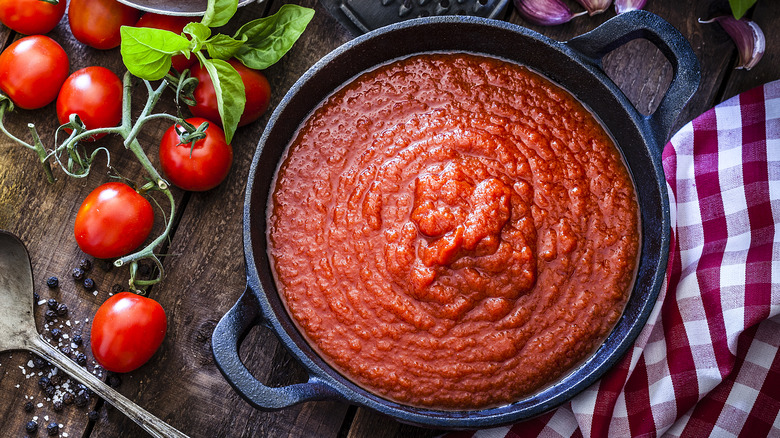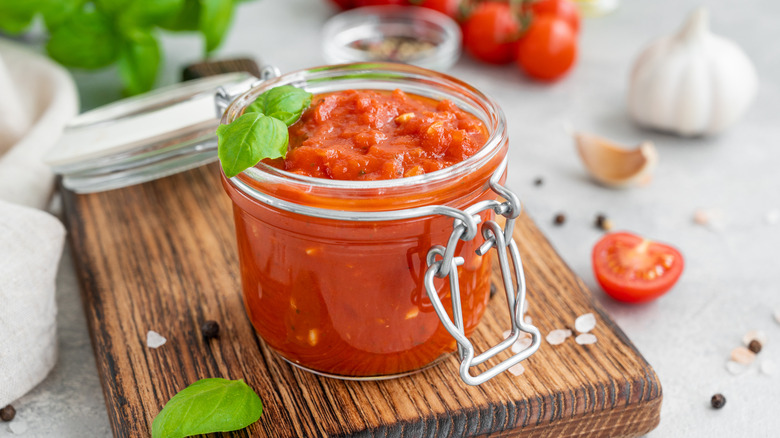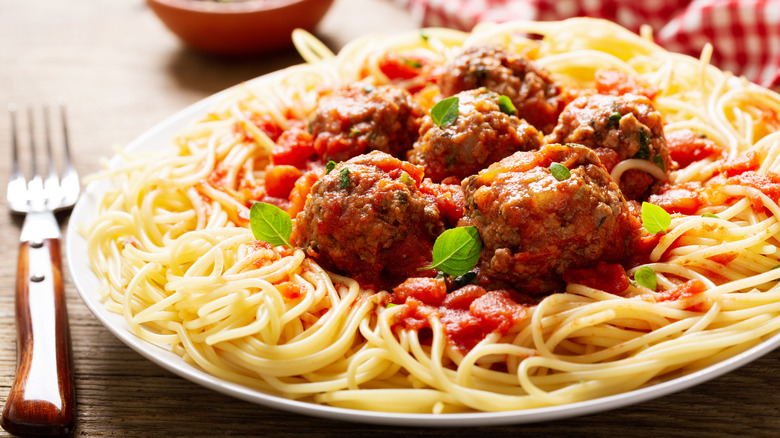The Origin Story Of Marinara, A Sauce Of Both The Old World And The New
Marinara, also known as red sauce, is one of the most ubiquitous sauces in both Italian and Italian-American cuisine. Its composition is relatively simple, with most basic marinara recipes only calling for tomatoes, olive oil, garlic, herbs, and sometimes onion. The naturally MSG-laden tomatoes bring acidity and enhance flavor, while the garlic and onions offer a fresh bit of spice. Finally, the olive oil adds richness, creating a sauce that's tangy, sweet, spicy, and a great pairing for countless dishes.
Like any classic dish, marinara sauce has a long and rich history that spans oceans, centuries, and countries. While the exact date when marinara sauce was invented is unknown, it's unlikely that it was developed any earlier than the 16th century, as Spaniards didn't bring tomatoes back to Europe until the 1500s. There, the fruit eventually became a popular and integral part of many Italian recipes, including the now-beloved marinara sauce.
The first marinara sauces
Marinara's birthplace is thought to be either Naples or Sicily. To its credit, Naples is an important part of pizza's history, as it's where the first pie was made. Similarly, while flatbreads have been around for centuries, the addition of tomatoes (and eventually marinara sauce) is what really transformed flatbread into what we now know as pizza. What's thought to be the first recipe for tomato sauce (though not marinara specifically) came from a Neapolitan cookbook author in 1692, but both Southern Italian cities claim marinara as their own.
Stories about the origins of both marinara sauce and its name abound. The word "marinara" comes from "marina," the Italian word for marine, and roughly translates to "sailor style." This is perplexing, as marinara isn't typically paired with seafood, nor does it include any seafood ingredients. Even so, various stories have tried to explain how the sauce got its seafaring start.
Some believe sailors and fishermen would make the sauce on their ships while voyaging. One story even claims that the sauce was created on Europeans' voyage back from the Americas since sailors had all the necessary ingredients on board, though no widely available historical records seem to confirm this. A more charming story posits that sailors' wives would see their husbands docking boats and would start making the sauce to welcome them home, as marinara is quick to make and contains simple ingredients.
Marinara returns to America
Outside of Italy, marinara has a unique history among Italian Americans. Though Europeans had been traveling to and settling in the Americas for centuries, mass emigration from Italy to America didn't begin until the 1800s. Millions of laborers and farmers hoping for prosperity made their way to America, and they brought marinara sauce with them. When you visit an Italian restaurant in the U.S. today, you may overhear someone ordering a plate of spaghetti and gravy, as that's a common name for red pasta sauce in Italian-American cuisine.
Those who came to America from Italy began developing unique spending and dining habits since they could afford food more readily. This, in turn, transformed and added ingredients to marinara over time. Bolognese sauce, for example — originally little more than minced meat in marinara sauce — was invented sometime in the 1700s but likely didn't include the chunks of meat we expect today. With higher wages and more access to meat in the States, Italian immigrants gave the previously vegetarian marinara sauce the meat-lovers treatment, resulting in what is essentially marinara sauce and meatballs served on spaghetti. Thanks to this history, we now have the modern classic spaghetti and meatballs, a dish that's perhaps more American than it is Italian.


